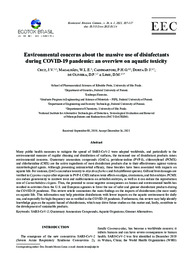Environmental concerns about the massive use of disinfectants during COVID-19 pandemic: an overview on aquatic toxicity.
Environmental concerns about the massive use of disinfectants during COVID-19 pandemic: an overview on aquatic toxicity.
Autoria: CRUZ, J. V.; MAGALHAES, W. L. E.; CADEMARTORI, P. H. G.; DORTA D. J.; OLIVEIRA, D. P. de; LEME, D. M.
Resumo: Many public health measures to mitigate the spread of SARS-CoV-2 were adopted worldwide, and particularly to the environmental measure of regular cleaning and disinfection of surfaces, the increased use of disinfectant products raises environmental concerns. Quaternary ammonium compounds (QACs), povidone-iodine (PVP-I), chloroxylenol (PCMX) and chlorhexidine (CHX) are the active ingredients of most disinfectant products due to their effectiveness against various microbiological agents. Although presenting antimicrobial efficacy, these biocides have been associated with impacts on aquatic life. For instance, QACs can induce toxicity to Aliivibrio fischeri and fish (different species). Gill and liver damages are verified in Cyprinus carpio after exposure to PVP-I. CHX induces toxic effects on algae, crustaceans, and fish embryos. PCMX can induce genotoxicity to rainbow trout and malformations on zebrafish embryos, as well as it can reduce the reproduction rate of Caenorhabditis elegans. Thus, the potential to cause negative consequences on human and environmental health has resulted in activities from the U.S. and European agencies to favor the use of safer and greener disinfectant products during the COVID-19 pandemic. This review article summarizes the main findings on the impacts of disinfectants (the most used) on aquatic life. This information may help prioritize disinfectants with lower impacts on the aquatic environment for daily use, and especially for high-frequency use as verified in the COVID-19 pandemic. Furthermore, this review may help identify knowledge gaps on the aquatic hazard of disinfectants, which may drive future studies on this matter and, lastly, contribute to the development of sustainable products.
Ano de publicação: 2021
Tipo de publicação: Artigo de periódico
Unidade: Embrapa Florestas
Observações
1 - Por padrão são exibidas publicações dos últimos 20 anos. Para encontrar publicações mais antigas, configure o filtro ano de publicação, colocando o ano a partir do qual você deseja encontrar publicações. O filtro está na coluna da esquerda na busca acima.
2 - Para ler algumas publicações da Embrapa (apenas as que estão em formato ePub), é necessário ter, no celular ou computador, um desses softwares gratuitos. Sistemas Android: Google Play Livros; IOS: iBooks; Windows e Linux: software Calibre.
Acesse outras publicações
Acesse a Base de Dados da Pesquisa Agropecuária (BDPA) para consultar o acervo completo das bibliotecas da Embrapa.

